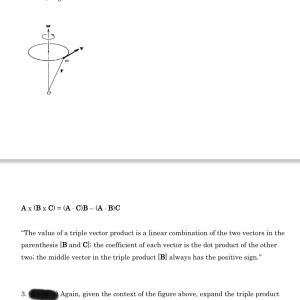Vector Analysis - Angular Momentum and Acceleration
Answer
2) We start by using the vector triple product to write our angular momentum as:
$\vec{L} = m\left((\vec{r}\cdot\vec{r})\vec{\omega} - (\vec{r}\cdot\vec{\omega})\vec{r}\right)$
Now as $\vec{r}$ is perpendicular to $\vec{\omega}$, we know the dot product is zero, $\vec{r}\cdot\vec{\omega} = 0$. This allows us to get rid of the term on the right side. Second, a dot product of a vector with itself is its magnitude squared, which we can write: $\vec{r}\cdot\vec{r} = r^2$. Therefore our angular momentum is written as:
$\vec{L} = m r^2 \vec{\omega}$
We now want to find the magnitude of our angular momentum:
$\vert \vec L \vert = m r^2 \vert \vec\omega \vert$
We note that since $\vec r$ and $\vec\omega$ are perpendicular, we get:
$\vert\vec\omega\vert = \frac{v}{r}$
Plugging back in to our angular momentum formula we recover the elementary form:
$\vert \vec L \vert = m v r$
3) Here we follow a similar procedure and use the triple product to write:
$\vec{a} = \vec{\omega} \times (\vec\omega \times \vec{r}) = (\vec\omega \cdot \vec r)\vec\omega - (\vec\omega\cdot\vec\omega)\vec r$
Again as $\vec\omega$ and $\vec r$ are perpendicular, their dot product is zero, and the first term drops to give:
$\vec{a} = - (\vec\omega\cdot\vec\omega)\vec r$
We simplify with $\vec\omega\cdot\vec\omega = \omega^2$ to give the desired result:
$\vec{a} = - \omega^2\vec r$
- answered
- 3351 views
- $12.00
Related Questions
- Functions, matrices, determinates, differentation questions.
- Find a vector parametric form and symmetric form, find minimal distance betwen L and P, consider vectors v and w.
- How do I evaluate and interpret these sets of vectors and their geometric descriptions?
- Help deriving an equation from geometry and vectors
- Three vectors question
- Pulley System
- Rectangular and Cylindrical Coordinates
- Vectors - Lines and Planes

